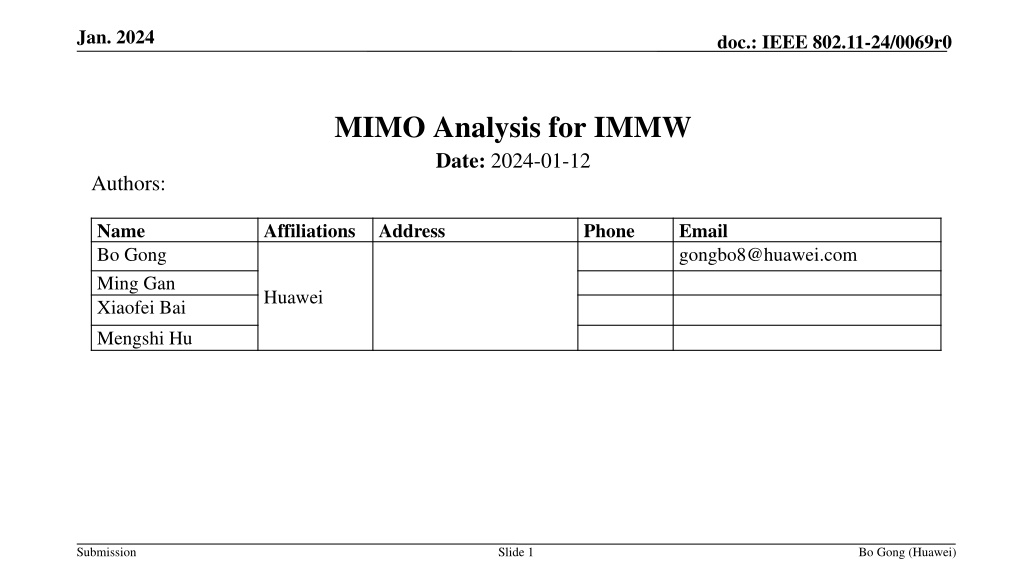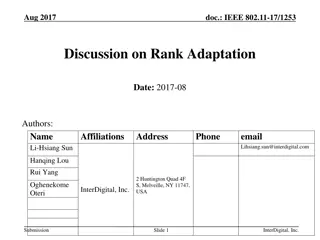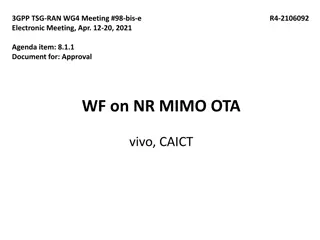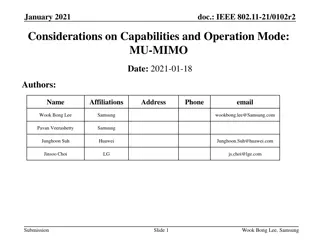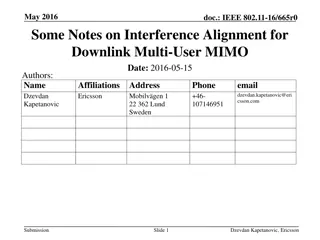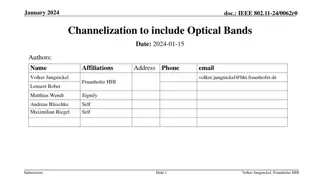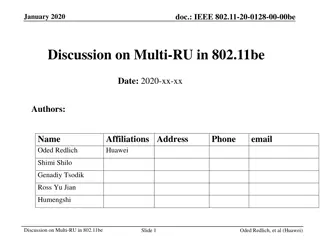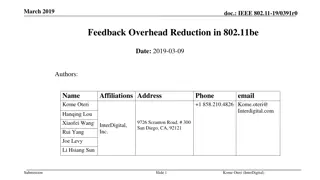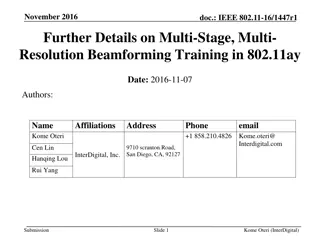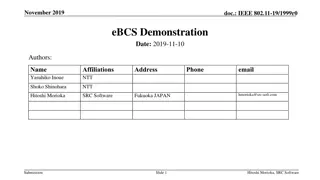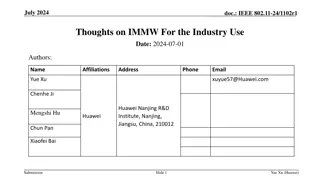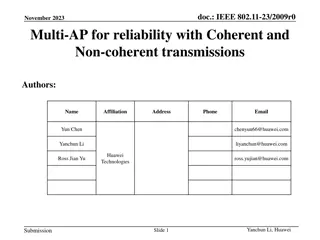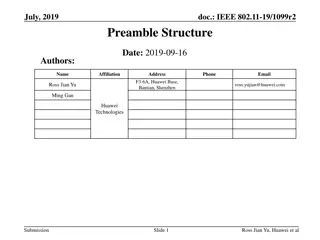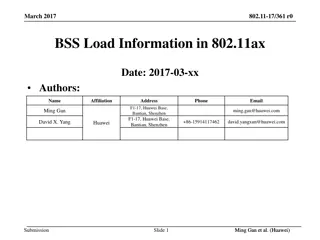Analysis of MIMO for IMMW Transmission in IEEE 802.11-24
Proposal discusses the suitability of MIMO for IMMW transmission under different scenarios. The analysis focuses on the number of spatial streams based on channel rank and quality, recommending dual-polarization for LOS paths supporting 2 spatial streams and spatial separation for larger devices supporting 4 streams. Overall, the proposal suggests using 2 spatial streams for typical scenarios to enhance throughput.
Download Presentation

Please find below an Image/Link to download the presentation.
The content on the website is provided AS IS for your information and personal use only. It may not be sold, licensed, or shared on other websites without obtaining consent from the author. Download presentation by click this link. If you encounter any issues during the download, it is possible that the publisher has removed the file from their server.
E N D
Presentation Transcript
Jan. 2024 doc.: IEEE 802.11-24/0069r0 MIMO Analysis for IMMW Date: 2024-01-12 Authors: Name Bo Gong Ming Gan Xiaofei Bai Mengshi Hu Affiliations Address Phone Email gongbo8@huawei.com Huawei Submission Slide 1 Bo Gong (Huawei)
Jan. 2024 doc.: IEEE 802.11-24/0069r0 Background and Motivation IMMW SG has been setup for discussion of integrated baseband of sub-7G and super-45G, which is intended to support millimeter wave transmission at the lowest cost. Taking account for the applications which have special requirements for throughput, such as AR/VR, MIMO can be taken as an optional feature to improve the throughput. This proposal analyzes the possible number of spatial streams of SU MIMO, which provides reference for the determination of the throughput in IMMW PAR. Submission Slide 2 Bo Gong (Huawei)
Jan. 2024 doc.: IEEE 802.11-24/0069r0 Possible Number of Spatial Streams for Typical Scenarios For APs and non-AP STAs under typical scenarios, such as routers and mobile phones, the analysis should be based on far-field antenna model; As analyzed in Appendix and proved by product test, the rank of the channel with LOS path is usually 1. The reason is that the strength of the reflection path is much lower than the LOS path due to the large reflection loss. In addition, the rank of the channel without LOS path will not exceed 2~5. The channel quality is usually worse due to the large reflection loss. Submission Slide 3 Bo Gong (Huawei)
Jan. 2024 doc.: IEEE 802.11-24/0069r0 Recommended MIMO Scheme for Typical Scenarios (1) For the rank 1 LOS path channel, dual-polarization can be adopted to support 2 spatial streams. (2) For the channel without LOS path, on the one hand, it doesn t come up very often; On the other hand, the channel quality is usually unsatisfactory. Thus, 2 spatial streams are regarded as enough. Submission Slide 4 Bo Gong (Huawei)
Jan. 2024 doc.: IEEE 802.11-24/0069r0 Possible Number of Spatial Streams for Some Other Scenarios For some other scenarios with larger devices and closer distances, the analysis can also be based on near-field antenna model; Dual-polarization can be adopted to support 2 spatial streams. Spatial Separation supports 2 spatial streams with antenna distance 30cm and transmitter-receiver distance 2m [2]. Note that the Half Power Beamwidth (HPBW) is equal to 14.00. It is challenging for implementation to some degree. Static device Moving device RX PAA 1 TX PAA 1 Direct link H11 RX PAA 2 TX PAA 2 18 cm Interfered link H21 Simultaneous dual-polarization and Spatial Separation can be adopted to support 4 spatial streams. 18 cm 0 200 cm Y 30 cm X Submission Slide 5 Bo Gong (Huawei)
Jan. 2024 doc.: IEEE 802.11-24/0069r0 Summary In this proposal, we analyze the possible number of spatial streams and recommend two spatial streams for typical scenarios. Submission Slide 6 Bo Gong (Huawei)
Jan. 2024 doc.: IEEE 802.11-24/0069r0 Appendix Submission Slide 7 Bo Gong (Huawei)
Jan. 2024 doc.: IEEE 802.11-24/0069r0 Part I : Relationship between Multi-path and Channel Rank (1) Tx1 Tx2 TxM Consider the scenario with M Tx antenna panels connected to M Tx RF Chains M Rx antenna panels connected to M Rx RF Chains L multi-paths Assume that The gain of the l-th path is ??, where ? 1, The steering vector of the receive antennas for the l-th path is ?? and ??. The notation ?? means the antenna pattern of the m-th receiveantenna, ? 1,? . L-th 2nd ? ; 1st ?, in which ?? ? is related to ?? ? ? means the AoA of the l-th path to the m-th receiveantenna and ?? ?, in which ?? ? is related to ?? ? and The steering vector of the transmit antennas for the l-th is ?? ??. The notation ?? the antenna pattern of the m-th transmitantenna, ? 1,? . ? means the AoD of the l-th path to the m-th transmitantenna and ?? means Rx1 Rx2 RxM Submission Slide 8 Bo Gong (Huawei)
Jan. 2024 doc.: IEEE 802.11-24/0069r0 Part I : Relationship between Multi-path and Channel Rank (2) Assume that ?, ?, ??= ?? ?1?, we have ?1 ?2 ?? in which, ? ?2 , ?? ?1 ?2 ?? ? ? ? ??, ? ??, ? + ?, ? ?? = ?=1 ?=1 ?=1 ?1 ?2 , ?? ???denotes the transmit data for M spatial streams, ???denotes the receive data for M receive antennas. It can be found that ?=1 ?? It means that the rank of the channel matrix won t exceed the number of multi-paths. Note that if a beam doesn t pass partial multi-paths, the corresponding coefficients of the steering vector are 0, which doesn t affect the conclusion. , ?1, ?1, ?2, ?2, , ? ? ?? can be regarded as a linear combination of ?1,?2, ,??. The proof process comes from reference [3]. Submission Slide 9 Bo Gong (Huawei)
Jan. 2024 doc.: IEEE 802.11-24/0069r0 Part II : Rank Analysis for Channel with LOS Path (1) For IEEE Channel Models for 60GHz WLAN Systems, there exists 3 channel modes, including conference room channel model, cubicle environment channel model and living room channel model. The multi-path component can be summarized as follows [1]. Table 1 Multipath of conference room Table 2 Multipath of cubicle environment Table 3 Multipath of living room Type of Path LOS path Reflection from OW#1 (office wall) Reflection from OW#2 Reflection from CW#1 (cubicle wall) Reflection from CW#2 Reflection from CW#3 Reflection from CW#4 Reflection from table Reflection from table and then ceiling Cubicle #1 1 1 Cubicle #2 1 1 Cubicle #5 1 1 Number of paths for STA-AP sub-scenario Type of paths Type of Paths Number of Paths 1 LOS path First order reflections from walls 1 4 LOS path 1 1 1 0 0 0 First order reflections from walls 3 Second order reflections from two walls First order reflections from ceiling and floor 2 8 Second order reflections from two walls 5 1 0 0 1 0 1 1 0 1 0 0 0 1 1 1 Second order reflections from ceiling and floor 2 First order reflection from ceiling - Second order reflections from the wall and ceiling, from the wall and floor 6 Second order reflections from the walls and ceiling* - Submission Slide 10 Bo Gong (Huawei)
Jan. 2024 doc.: IEEE 802.11-24/0069r0 Part II : Rank Analysis for Channel with LOS Path (2) The strength of the multi-paths is analyzed as follows [1]. (1) For LOS path, the path gain is A(0) = /(4 d), where is a wavelength, and d is a separation between TX and RX. (3) Considering that A(i)= g(i) 1 ?), 4 ? (1+? (0) can be expressed as The signal receive power ??? beside reflection path and about -16dB for the second order reflection path. ?< 1, g(i) is about -10dB for the first order 1 (0)= ???????(0)2??? ? 1+ ??? = ??????( ? 4??)2??? where Gtx and Grx are TX and RX antennas gains respectively and Ptx is the transmitted power. (2) For NLOS path, the path gain is (0), ??? (?)is about -20dB to (4) It means that compared with ??? -32dB lower. The obvious strength gap results in that the NLOS path can be ignored. Thus, for channel with LOS path, the rank of the channel matrix is approximately 1. A(i)= g(i) / (4 (d + R)); R = c ; g(i)is the reflection loss. R is a distance along the path larger than d, R is calculated as a product of TOA relatively LOS and the speed of light c. (?) can be expressed as The signal receive power ??? (?)= ???????(?)2???; ??? Submission Slide 11 Bo Gong (Huawei)
Jan. 2024 doc.: IEEE 802.11-24/0069r0 Part III :Rank Analysis for Channel without LOS Path (1) For the channel without LOS path, For conference room and living room model, the mean value of the reflection loss g(i) for the first order reflection path is about -10dB. The mean value of the reflection loss g(i) for the second order reflection path is about -16dB. The receive power gap between the first and the second order reflection path is about -12dB. Thus, we can ignore the second order reflection path and mainly focus on the first order reflection path to simplify the analysis. For the cubicle environment, the mean values of the reflection loss g(i) are almost the same for the first order reflections and the second order reflections. Thus, we consider the first and the second order reflection paths together. Submission Slide 12 Bo Gong (Huawei)
Jan. 2024 doc.: IEEE 802.11-24/0069r0 Part III : Rank Analysis for Channel without LOS Path (2) Probabilities of path blockage The probability of single path blockage for the first order reflections from walls is 0.126; Probability of 1 path is ?4 Probability of 2 path is ?4 Probability of 3 path is ?4 Probability of 4 path is 1 0.1264= 0.58 For conference room, there are mainly 3~4 paths. Table 1 Multipath of conference room Number of paths for STA-AP sub-scenario Type of paths 1 1 0.126 0.1263= 0.01 LOS path First order reflections from walls 1 4 2 1 0.1262 0.1262= 0.07 Second order reflections from two walls 8 3 1 0.1263 0.126 = 0.34 First order reflection from ceiling - Second order reflections from the walls and ceiling* - Submission Slide 13 Bo Gong (Huawei)
Jan. 2024 doc.: IEEE 802.11-24/0069r0 Part III : Rank Analysis for Channel without LOS Path (3) Probabilities of path blockage Table 2 Multipath of cubicle environment Type of Path LOS path Reflection from OW#1 (office wall) Reflection from OW#2 Reflection from CW#1 (cubicle wall) Reflection from CW#2 Reflection from CW#3 Reflection from CW#4 Reflection from table Reflection from table and then ceiling Cubicle #1 1 1 Cubicle #2 1 1 Cubicle #5 1 1 For Cubicle #5, LOS path is always existing. For Cubicle #1 and #2, there exists 3, 4, or 5 NLOS paths with probabilities 0.5, 0.2, and 0.3 accordingly. There are mainly 3~5 paths. 1 1 1 0 0 0 1 0 0 1 0 1 1 0 1 0 0 0 1 1 1 Submission Slide 14 Bo Gong (Huawei)
Jan. 2024 doc.: IEEE 802.11-24/0069r0 Part III : Rank Analysis for Channel without LOS Path (4) Probabilities of path blockage Table 3 Multipath of living room Probability of 1 path is 0.7 0.43= 0.04 Probability of 2 path is (1 0.7) 0.43+0.7 ?3 Probability of 3 path is (1 0.4) 0.7 ?3 Probability of 4 path is (1 0.7) ?3 Probability of 5 path is (1 0.4)3 (1 0.7) = 0.06 There are mainly 2~4 paths. Type of Paths Number of Paths 1 LOS path 1 0.42 = 0.22 First order reflections from walls 3 First order reflections from ceiling and floor 2 2 (1 0.4)2 0.4 + (1 0.7) ?3 1 (1 0.4) 0.42 = 0.39 Second order reflections from two walls 5 Second order reflections from ceiling and floor 2 1 0.4 (1 0.4)2+ 0.7 (1 0.4)3 = 0.28 Second order reflections from the wall and ceiling, from the wall and floor 6 Table 4 Probabilities of paths blockage for the living room model Probability of Path blockage 0.4 Path type First order reflections from walls (3) For the channel without LOS paths, there are mainly 2~5 paths, which means the rank of the channel won t exceed 2~5. First order reflections from ceiling (1) 0 First order reflections from floor (1) 0.7 Submission Slide 15 Bo Gong (Huawei)
Jan. 2024 doc.: IEEE 802.11-24/0069r0 References [1] IEEE doc. 802.11-09/0334r8. Channel models for 60 GHz WLAN systems, A. Maltsev et al, Mar. 2010. [2] 11-15-0632-01-00ay-experimental-measurements-for-short-range-los-su-mimo. [3] X. Li, J. Fang, H. Li, and P. Wang, Millimeter wave channel estimation via exploiting joint sparse and low-rank structures, IEEE Transactions on Wireless Communications, vol. 17, no. 2, pp. 1123 1133, 2017 Submission Slide 16 Bo Gong (Huawei)
